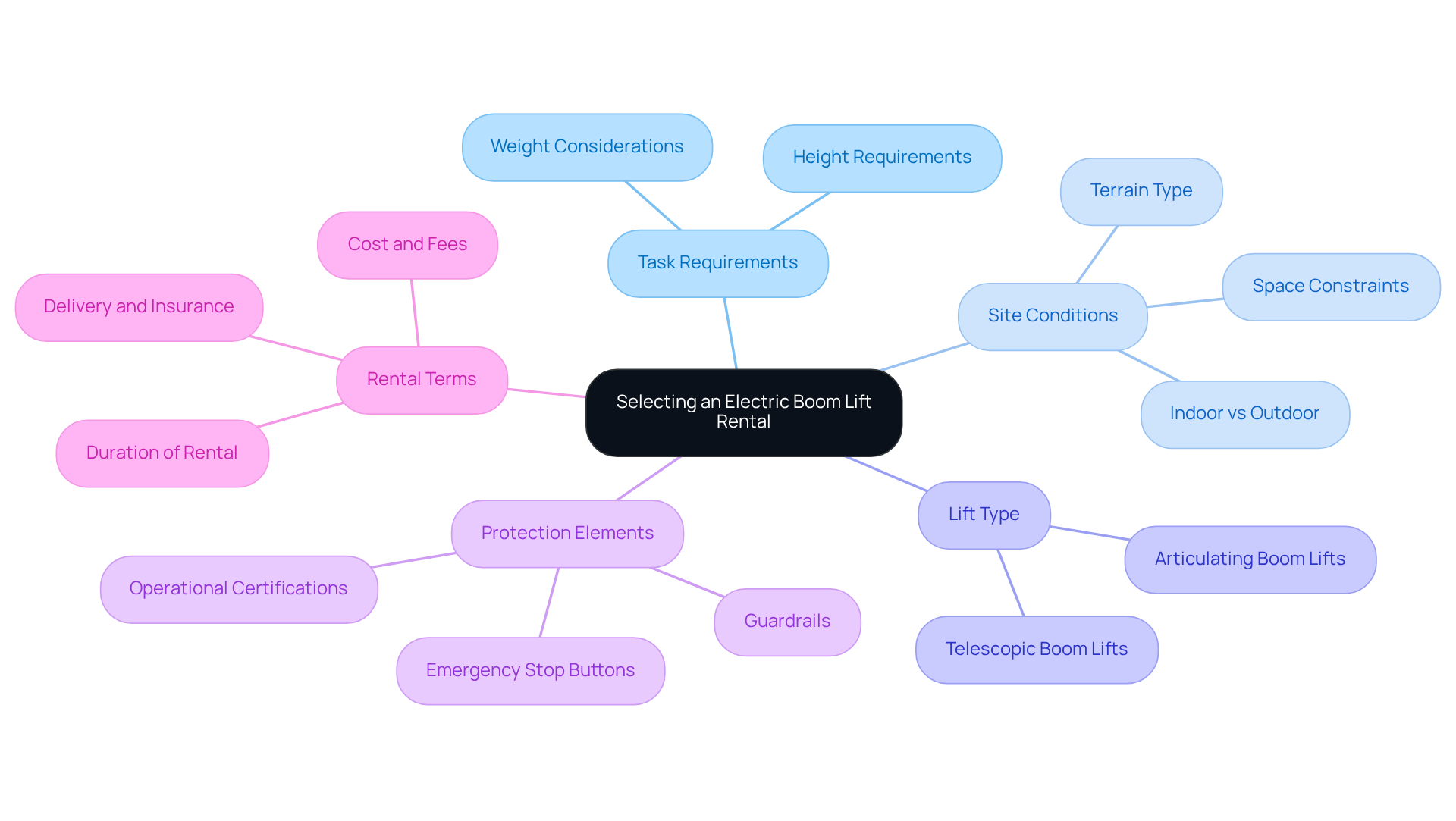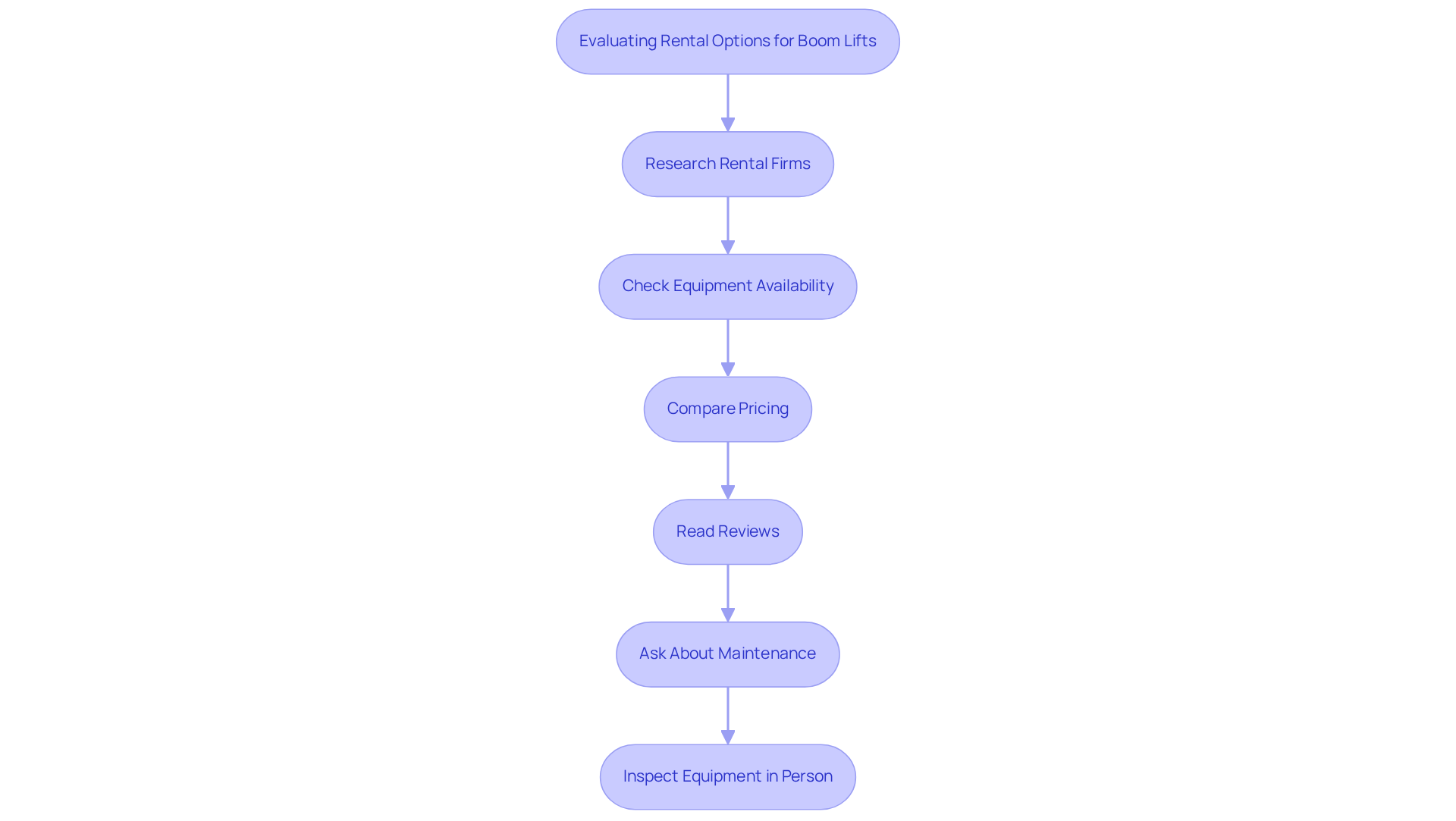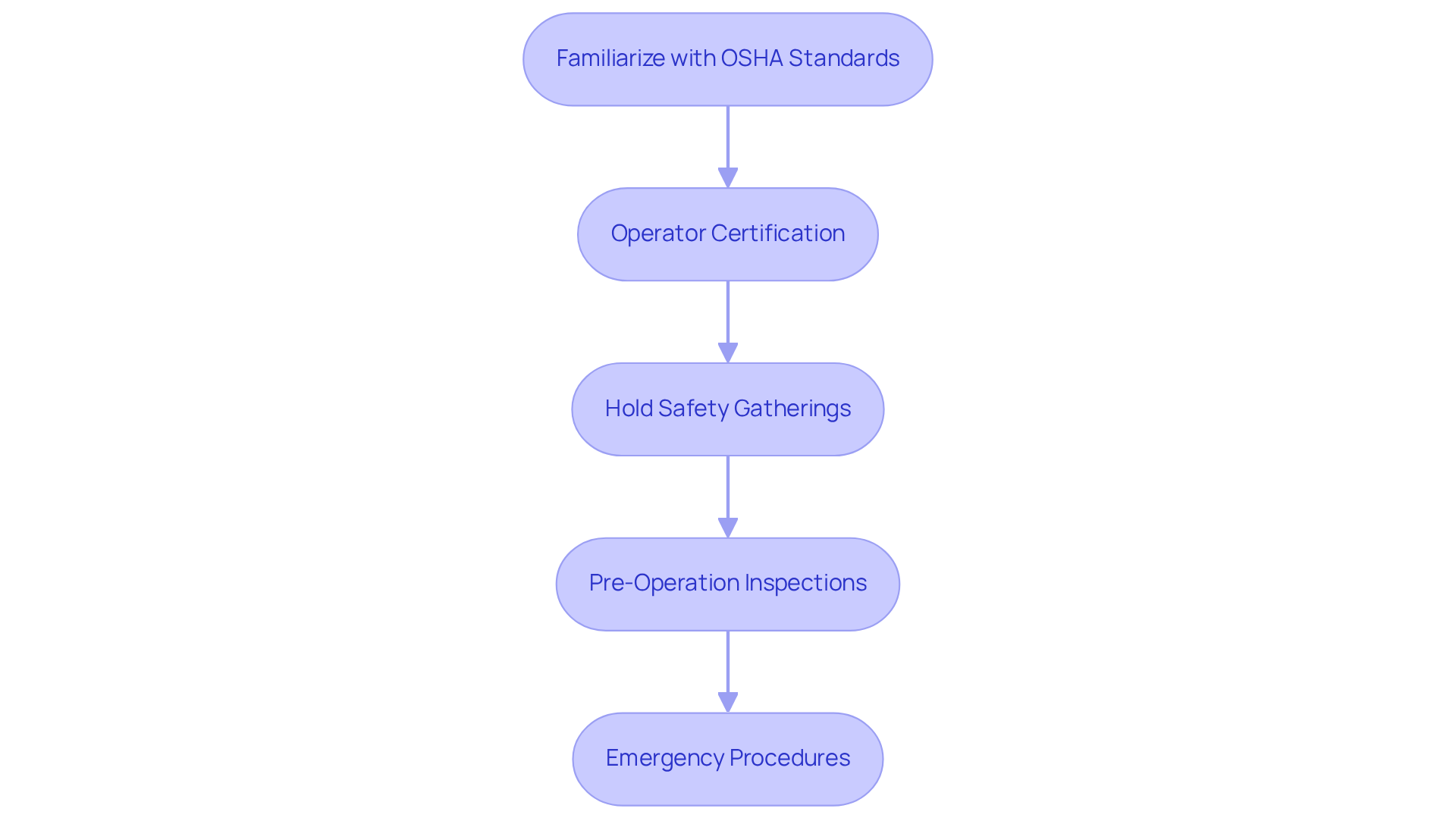Key Highlights:
- Assess task requirements by evaluating necessary height and weight capacity for the boom lift.
- Analyse site conditions, considering whether the project is indoors or outdoors and any space constraints.
- Choose between articulating and telescopic boom lifts based on project needs; articulating for obstacles and telescopic for extended reach.
- Ensure the lift has safety features like guardrails and emergency stops, and comply with OSHA and ANSI standards.
- Review rental terms carefully, including duration, costs, and potential hidden fees.
- Research and compare local rental firms, focusing on their reputation, equipment availability, and pricing.
- Read customer reviews to assess previous clients' experiences with equipment and services.
- Inquire about maintenance protocols and support during the rental period to ensure equipment reliability.
- Familiarise with OSHA standards and ensure all operators receive proper training and certification.
- Conduct regular safety meetings to reinforce safety procedures and identify hazards.
- Implement pre-operation inspections to cheque for equipment damage and functionality of safety features.
- Establish clear emergency procedures for equipment failure or accidents to ensure team preparedness.
Introduction
Choosing the right electric boom lift rental can significantly impact the success of your project. Yet, many project managers often overlook the critical factors that should guide their decision-making process. This guide outlines essential steps for evaluating options, comparing providers, and ensuring compliance with safety regulations. By following these steps, managers can enhance both project efficiency and safety.
With numerous variables at play, navigating the complexities of selecting the best equipment without compromising on quality or safety can be daunting. Understanding the available services and their benefits is crucial. Each type of equipment offers unique advantages that can streamline operations and improve outcomes. For instance, electric boom lifts are known for their versatility and ease of use, making them ideal for various job sites.
Furthermore, reliability and quality are paramount when it comes to equipment rental. Statistics show that projects utilizing high-quality equipment experience fewer delays and reduced costs. Testimonials from satisfied customers highlight the importance of choosing a reputable provider. Their experiences can serve as a valuable resource in your decision-making process.
In conclusion, taking the time to evaluate your options will pay off in the long run. Don’t hesitate to reach out for assistance or to explore your rental options today. Your project deserves the best equipment to ensure its success.
Identify Key Factors for Selecting an Electric Boom Lift Rental
Choosing the appropriate electric boom lift rental is essential for achieving project success. By carefully considering several key factors, you can ensure that your choice meets both operational needs and safety standards.
Task Requirements: Begin by evaluating the specific needs of your assignment. Consider the necessary height and the weight of materials or individuals to be lifted. This assessment is essential for identifying the suitable kind and capacity of the aerial platform.
Site Conditions: Next, analyze the work environment. Is the project taking place indoors or outdoors? Are there space constraints or uneven terrain? Electric hoists are particularly suitable for indoor uses due to their low emissions and quieter operation, while diesel versions are commonly favored for outdoor jobs.
Lift Type: Choose between articulating and telescopic boom devices. Articulating platforms excel at navigating obstacles, making them ideal for urban settings. In contrast, telescopic platforms provide extended horizontal reach, which is suitable for outdoor construction tasks requiring maximum elevation.
Protection Elements: Ensure that the lift is equipped with crucial protection elements, including guardrails, emergency stop buttons, and appropriate operational certifications. These features minimize accidents and injuries, creating a secure working environment. Familiarity with OSHA and ANSI standards for aerial equipment operation is also advised to ensure compliance and safety on the job site.
Rental Terms: Finally, review the rental agreement thoroughly. Pay attention to the duration, costs, and any additional fees for delivery or insurance. Comparing terms across various providers can help you identify the most cost-effective option.
By meticulously evaluating these factors, project managers can make informed decisions about electric boom lift rental that not only meet project goals but also uphold safety standards. This approach ultimately enhances project efficiency and success.

Evaluate Rental Options and Compare Providers
To effectively evaluate rental options and compare providers for boom lifts, follow these essential steps:
-
Research electric boom lift rental firms: Begin by identifying nearby equipment rental businesses that specialize in aerial platforms. Focus on those with a solid reputation in the industry, such as EZ Equipment Rental, known for their commitment to quality machinery, including skid steers and forklifts, as well as exceptional customer satisfaction.
-
Check equipment availability by contacting multiple providers to confirm the availability of the specific electric boom lift rental models needed for your project. Ensure they can supply the appropriate type and size of equipment to meet your needs.
-
Compare pricing for electric boom lift rental by requesting quotes from various rental companies. When comparing prices, consider not only the base rental rates but also additional costs such as delivery, pickup, and insurance. Be vigilant for hidden fees that could affect your overall budget.
-
Read reviews and testimonials: Investigate customer reviews and testimonials online to assess the experiences of previous clients with their electric boom lift rental. Pay attention to feedback regarding equipment condition, customer service, and reliability to gauge the provider's performance.
-
Ask about maintenance and support by inquiring about the maintenance protocols of the electric boom lift rental company. A reliable provider should conduct regular inspections and maintenance on their equipment to ensure safety and dependability. Additionally, ask about the support available during the rental period, including assistance in case of equipment failure.
-
If possible, visit the rental facility to inspect the electric boom lift rental equipment in person. Look for signs of wear and tear, and confirm that the lifts are well-maintained and in good working order.
By diligently assessing rental options and comparing suppliers, project managers can secure the best equipment for their projects while ensuring safety and reliability. For more information or to reserve your equipment, contact EZ Equipment Rental today at (214) 951-7800.

Understand Safety Regulations and Training Requirements
Understanding the operational guidelines and training prerequisites for using electric boom lift rental platforms is crucial for ensuring a safe work environment, especially in a bustling construction hub like Dallas. Here are key considerations:
-
Familiarize with OSHA Standards: The Occupational Safety and Health Administration (OSHA) sets forth essential regulations for the safe operation of aerial platforms. All operators must be well-versed in these standards to guarantee compliance and safety on the job site, particularly given the high volume of construction projects in urban development.
-
Operator Certification: It’s imperative that all personnel using aerial devices receive proper training and certification. This training should encompass the specific type of hoist being utilized, including its controls, safety features like harnesses and emergency stop buttons, and emergency protocols. OSHA requires operators to complete a comprehensive training program that includes both theoretical and practical components, ensuring they are proficient in safe operation practices. Non-compliance can lead to fines and increased liability for businesses, underscoring the critical nature of certification in a city where electric boom lift rental is essential for tasks such as window installations and facade maintenance.
-
Hold Safety Gatherings: Regular meetings are vital for discussing the proper use of aerial platforms, identifying potential hazards, and reinforcing safety procedures. This practice fosters a culture of safety and ensures that all team members understand their responsibilities and the importance of adhering to regulations, particularly in the context of ongoing urban development.
-
Pre-Operation Inspections: Implementing a thorough checklist for pre-operation inspections is essential. Operators should inspect the boom apparatus for visible damage, confirm that all safety features are functional, and ensure the equipment is suitable for the intended task. Regular inspections help prevent accidents and guarantee that the equipment operates safely, which is especially important in high-rise construction environments.
-
Emergency Procedures: Establishing clear emergency procedures is critical in the event of equipment failure or accidents. All team members must be trained on how to respond in emergencies, including the safe lowering of the elevator and evacuation procedures for personnel.
By adhering to these safety regulations and training requirements, project managers can significantly reduce the risk of accidents, ensuring a safe working environment for everyone involved in the project. Statistics show that proper training and certification can lower operator injuries, highlighting the importance of compliance in aerial lift operations, particularly in a city like Dallas where construction is a constant endeavor.

Conclusion
Selecting the right electric boom lift rental is crucial for project managers who want to ensure operational efficiency and safety on job sites. Understanding the essential factors in this decision-making process allows project managers to navigate the complexities of equipment rental while aligning with project goals and safety standards.
Key considerations include:
- Task requirements
- Site conditions
- Lift types
- Safety features
- Rental terms
Thorough research and comparison among providers are vital to securing the best equipment at a reasonable cost. Furthermore, understanding safety regulations and ensuring proper training for operators are critical components for minimizing risks and enhancing overall project success.
The insights shared here serve as a comprehensive guide for project managers in the construction industry. By applying these principles, managers can facilitate smoother operations and foster a culture of safety that protects their teams and enhances productivity. Embracing these best practices leads to more successful project outcomes and a safer work environment, highlighting the significance of informed decision-making in electric boom lift rentals.
Frequently Asked Questions
What are the key factors to consider when selecting an electric boom lift rental?
Key factors include task requirements, site conditions, lift type, protection elements, and rental terms.
How do I assess task requirements for an electric boom lift rental?
Evaluate the specific needs of your assignment by considering the necessary height and the weight of materials or individuals to be lifted.
What should I analyze regarding site conditions?
Determine if the project is indoors or outdoors, check for space constraints, and assess the terrain. Electric lifts are better for indoor use due to low emissions, while diesel lifts are preferred for outdoor jobs.
What is the difference between articulating and telescopic boom lifts?
Articulating boom lifts are ideal for navigating obstacles in urban settings, while telescopic boom lifts provide extended horizontal reach, suitable for outdoor construction tasks requiring maximum elevation.
What protection elements should be included with an electric boom lift?
The lift should have guardrails, emergency stop buttons, and appropriate operational certifications to minimize accidents and injuries.
Why is it important to be familiar with OSHA and ANSI standards?
Familiarity with OSHA and ANSI standards ensures compliance and safety when operating aerial equipment on the job site.
What should I review in the rental agreement?
Carefully check the duration, costs, and any additional fees for delivery or insurance to identify the most cost-effective option.
How can evaluating these factors enhance project success?
By considering these factors, project managers can make informed decisions that meet project goals and uphold safety standards, ultimately improving project efficiency and success.




